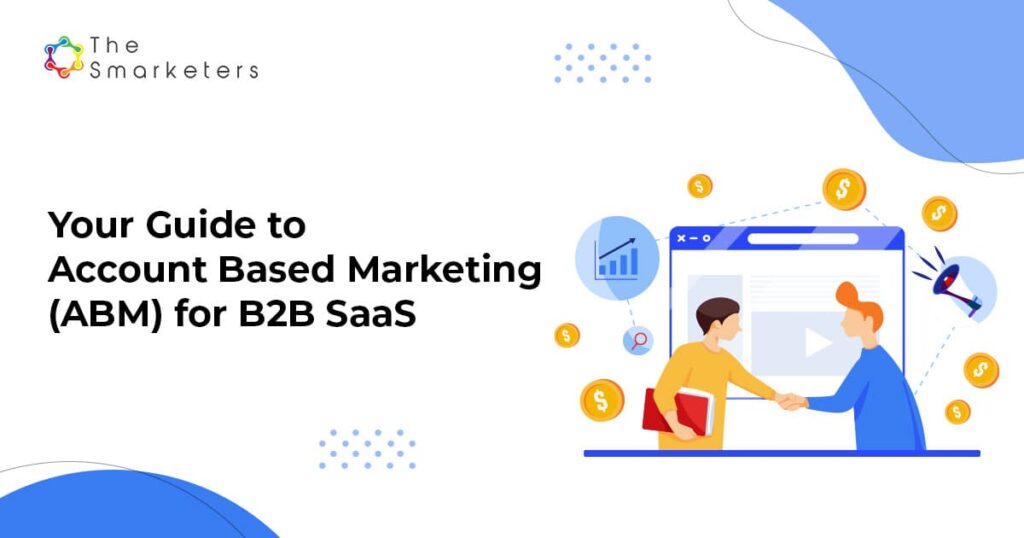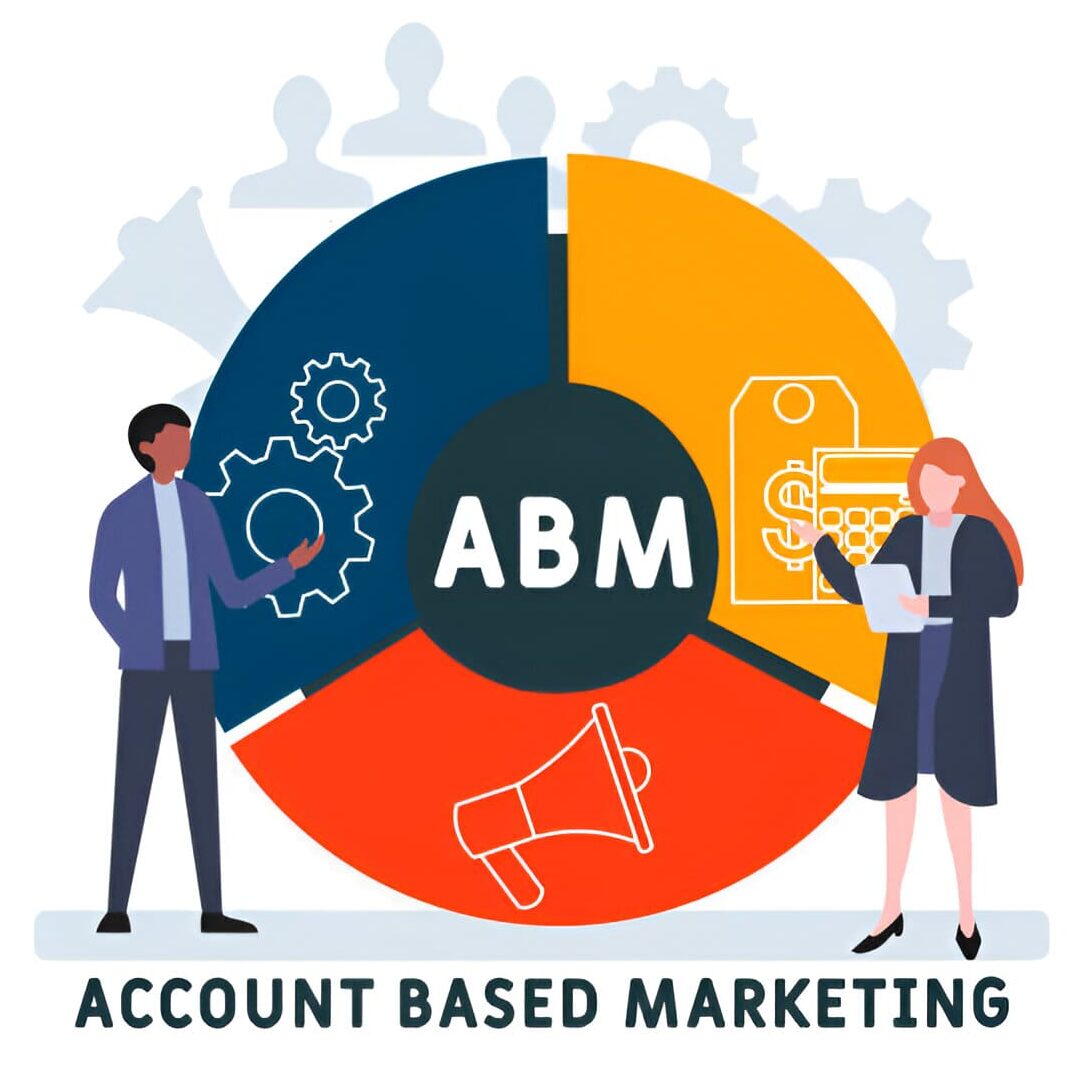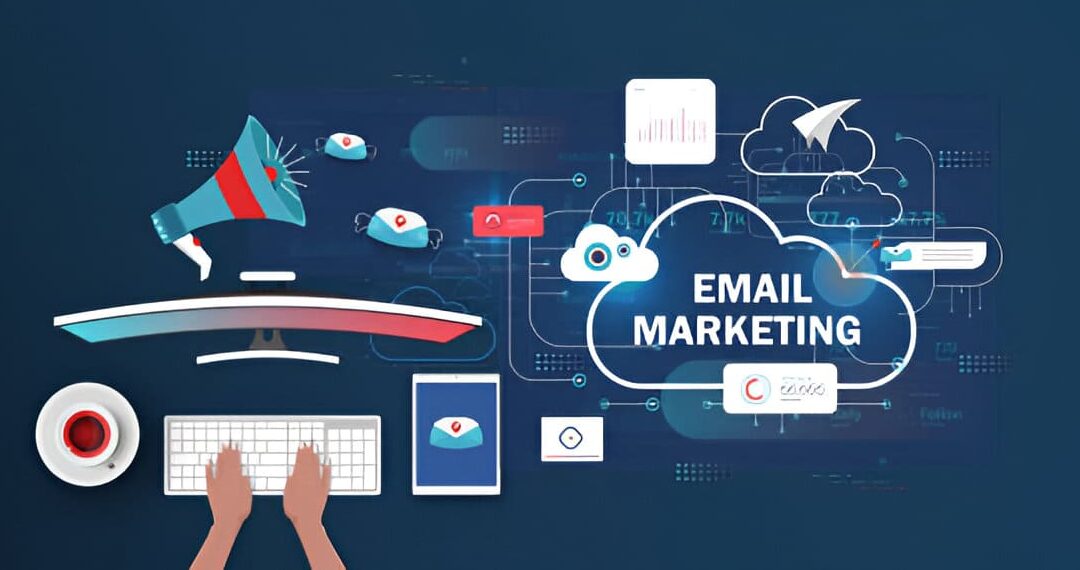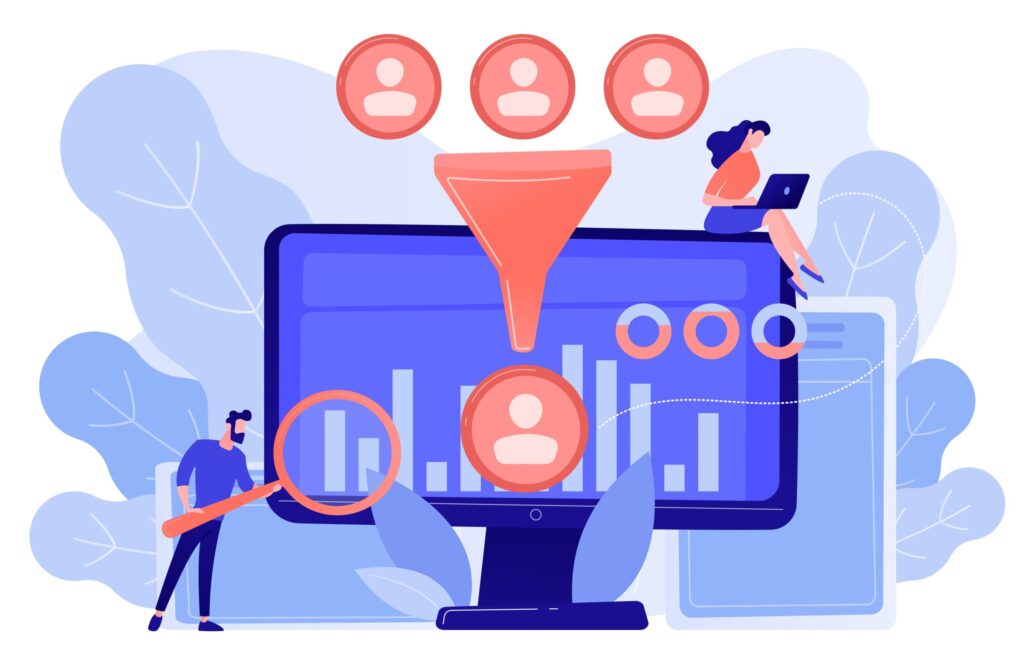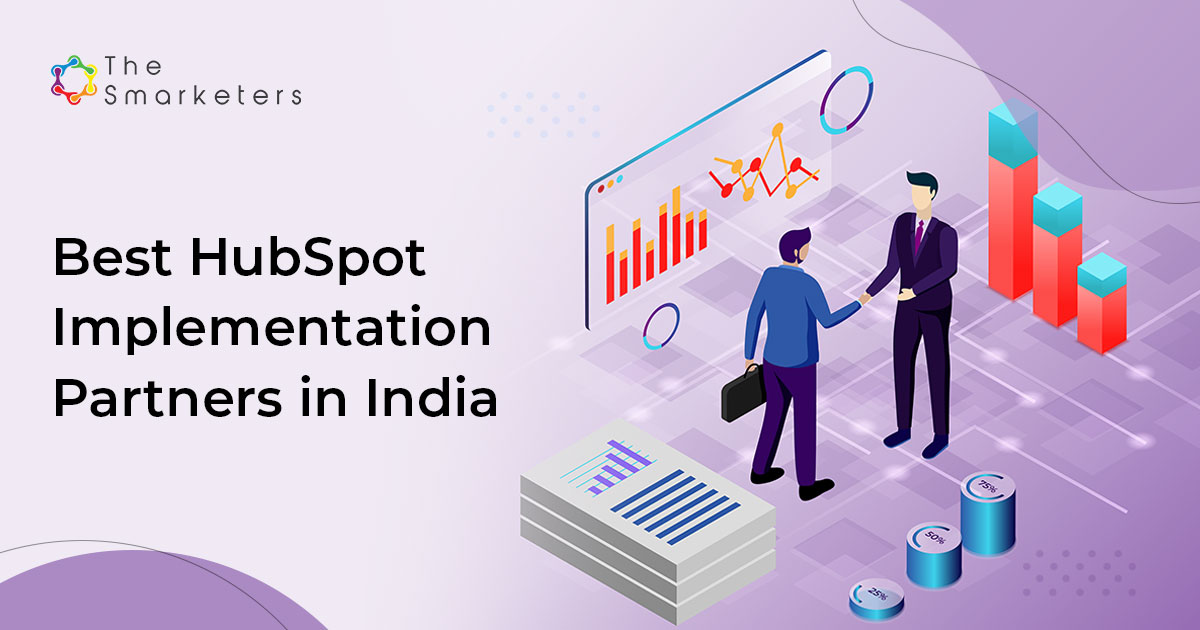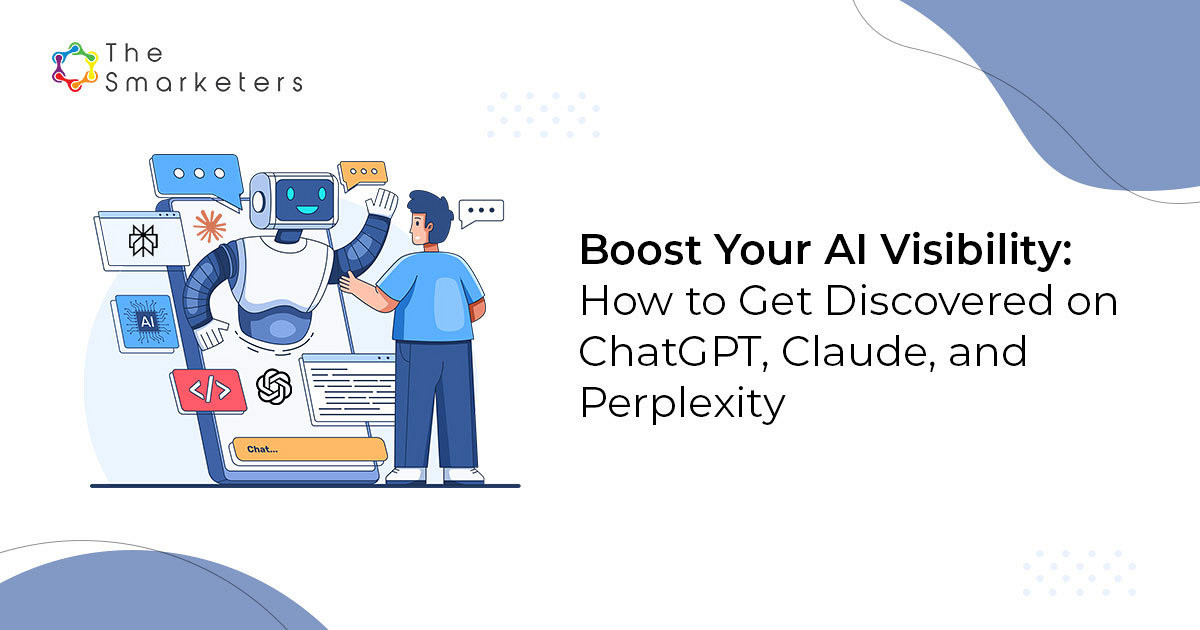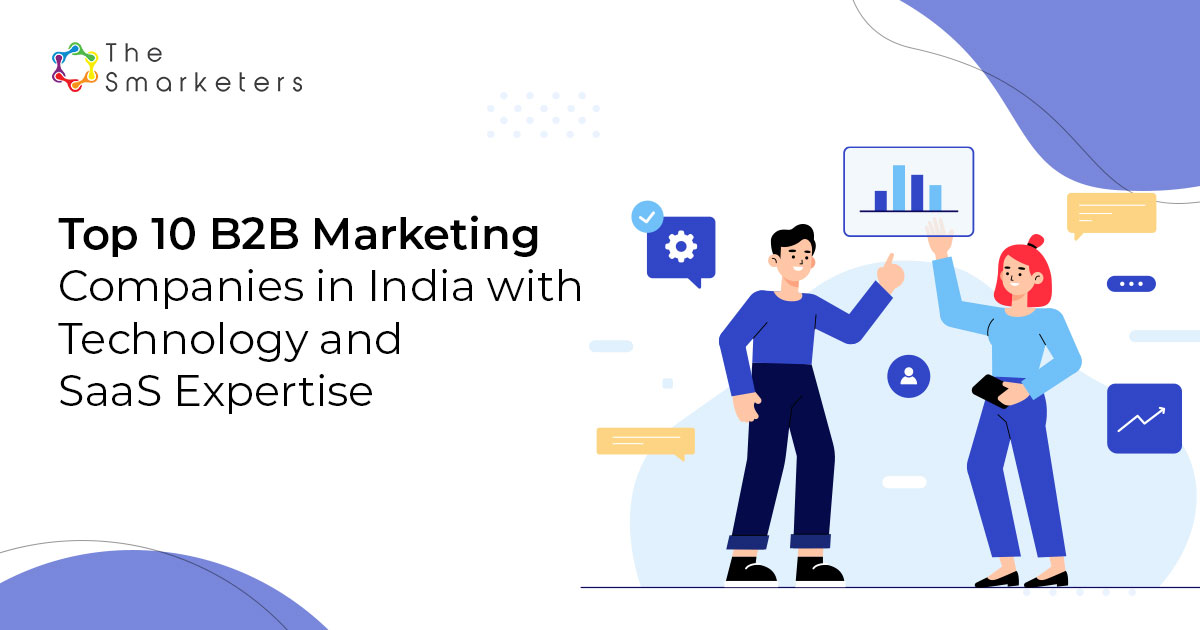Table of Contents
- Top 10 B2B Marketing Companies in India with Technology and SaaS Expertise
- Top 10 ABM Companies in India: Your Complete Guide to Finding the Right Partner in 2026
- Guide: How to find the right ABM agency for your organization?
- The Smarketers Wins Double Recognition at 16th Annual Web Excellence Awards
- Beyond the Buzz : How ABM AI Integration is Redefining B2B Marketing in 2025
Are you struggling to generate quality leads and close deals in the competitive B2B SaaS landscape? You’re not alone. Many businesses face the challenge of standing out in a crowded market and reaching decision-makers effectively. But what if there was a way to focus your efforts on the accounts that matter most and dramatically increase your conversion rates?
Enter Account Based Marketing (ABM) – a game-changing strategy that’s revolutionizing B2B sales and marketing. By targeting high-value accounts with personalized campaigns, ABM allows you to cut through the noise and speak directly to your ideal customers. It’s not just about casting a wide net anymore; it’s about fishing with a spear.
In this comprehensive guide, we’ll walk you through the essentials of implementing ABM for your B2B SaaS company. You’ll discover how to identify key accounts, align your sales and marketing teams, craft compelling personalized content, and measure your ABM success. Whether you’re new to ABM or looking to optimize your existing strategy, you’ll find actionable insights to take your B2B marketing to the next level. Let’s dive in and explore how Account Based Marketing can transform your approach to winning and retaining valuable clients.
Understanding Account Based Marketing (ABM)
Definition and core principles of ABM
Account Based Marketing (ABM) is a strategic approach in B2B marketing that focuses on treating individual high-value accounts as markets of one. This targeted methodology aligns sales and marketing efforts to create personalized campaigns for specific accounts, rather than casting a wide net to attract leads.
The core principles of ABM include:
- Account selection: Identifying and prioritizing high-value accounts that have the potential to generate significant revenue.
- Personalization: Tailoring content, messaging, and experiences to the specific needs and pain points of each target account.
- Multi-channel engagement: Utilizing various touchpoints and platforms to reach decision-makers within the target accounts.
- Sales and marketing alignment: Ensuring close collaboration between sales and marketing teams throughout the ABM process.
- Measurement and optimization: Continuously tracking and improving ABM efforts based on account-specific metrics and insights.
According to a recent study by the ITSMA, 87% of B2B marketers report that ABM initiatives outperform other marketing investments in terms of ROI. This statistic underscores the effectiveness of ABM in driving results for B2B SaaS companies.
Benefits for B2B SaaS companies
Implementing ABM can yield numerous advantages for B2B SaaS companies. Let’s explore some of the key benefits:
- Improved ROI: By focusing resources on high-value accounts, ABM helps SaaS companies maximize their marketing and sales investments.
- Shorter sales cycles: Personalized engagement and targeted messaging can accelerate the decision-making process for key accounts.
- Increased customer retention: ABM’s focus on building strong relationships with accounts can lead to higher customer loyalty and reduced churn.
- Better alignment between sales and marketing: ABM encourages closer collaboration between teams, resulting in more cohesive strategies and improved overall performance.
- Enhanced customer experience: Tailored content and interactions create a more relevant and valuable experience for target accounts.
- Higher average deal size: By targeting larger, high-value accounts, ABM can lead to more substantial contracts and increased revenue per customer.
- More efficient resource allocation: Concentrating efforts on specific accounts allows for better use of marketing and sales resources.
Here’s a comparison of the impact of ABM on various B2B SaaS metrics:
| Metric | Traditional Marketing | Account Based Marketing |
|---|---|---|
| Lead-to-Customer Conversion Rate | 1-2% | 5-15% |
| Average Deal Size | $25,000 | $100,000+ |
| Customer Lifetime Value | $50,000 | $200,000+ |
| Marketing ROI | 10% | 40%+ |
| Sales Cycle Length | 6-9 months | 3-6 months |
These figures demonstrate the significant improvements that ABM can bring to B2B SaaS companies across various key performance indicators.
Key differences between ABM and traditional marketing
While traditional marketing and ABM share the ultimate goal of driving business growth, they differ significantly in their approaches. Understanding these differences is crucial for B2B SaaS companies considering the implementation of ABM:
- Focus:
- Traditional marketing: Casts a wide net to attract a large number of leads
- ABM: Targets specific high-value accounts with personalized campaigns
- Lead generation:
- Traditional marketing: Emphasizes quantity of leads
- ABM: Prioritizes quality of accounts and depth of engagement
- Messaging:
- Traditional marketing: Generic messaging aimed at broad audience segments
- ABM: Tailored content addressing specific pain points of target accounts
- Sales and marketing alignment:
- Traditional marketing: Often operates in silos with limited collaboration
- ABM: Requires close coordination between sales and marketing teams
- Metrics:
- Traditional marketing: Focuses on lead-based metrics (e.g., MQLs, SQLs)
- ABM: Emphasizes account-based metrics (e.g., engagement rate, pipeline velocity)
- Campaign structure:
- Traditional marketing: Typically uses a linear funnel approach
- ABM: Employs a more holistic, multi-touch engagement strategy
- Resource allocation:
- Traditional marketing: Spreads resources across various initiatives
- ABM: Concentrates resources on high-priority accounts
- Personalization level:
- Traditional marketing: Limited personalization, often based on broad segments
- ABM: High degree of personalization tailored to individual accounts
- Technology stack:
- Traditional marketing: Relies on general-purpose marketing automation tools
- ABM: Utilizes specialized ABM platforms and intent data tools
- Timeline:
- Traditional marketing: Often focuses on short-term results and quick wins
- ABM: Emphasizes building long-term relationships and account value
A recent survey by Demand Gen Report found that 87% of B2B marketers agreed that ABM delivers a higher ROI than other marketing activities. This statistic highlights the growing recognition of ABM’s effectiveness in the B2B SaaS space.
To illustrate the impact of these differences, consider the following scenario:
A B2B SaaS company using traditional marketing might send out a generic email blast to thousands of contacts, hoping to generate a handful of leads. In contrast, an ABM approach would involve researching a specific target account, understanding their unique challenges, and crafting a personalized outreach campaign that addresses those pain points directly. This might include customized content, targeted ads, and coordinated outreach from both marketing and sales teams.
The result? While the traditional approach might generate more leads, the ABM strategy is more likely to result in meaningful engagement with decision-makers at high-value accounts, ultimately leading to larger deals and stronger customer relationships.
As you consider implementing ABM for your B2B SaaS company, it’s essential to evaluate your current marketing strategies and determine how ABM principles can be integrated to drive better results. With its focus on personalization, alignment, and targeted engagement, ABM offers a powerful approach to accelerating growth and maximizing the value of your most important accounts.
Next, we’ll explore how to identify and target key accounts effectively, a crucial step in implementing a successful ABM strategy for your B2B SaaS business.
Identifying and Targeting Key Accounts
Creating ideal customer profiles
In the world of Account Based Marketing (ABM) for B2B SaaS, creating ideal customer profiles (ICPs) is a crucial first step in identifying and targeting key accounts. By developing detailed ICPs, you’ll be able to focus your marketing efforts on the accounts most likely to convert and deliver the highest value to your business.
To create effective ICPs, consider the following factors:
- Company size and structure
- Industry and vertical
- Geographic location
- Technology stack and infrastructure
- Business challenges and pain points
- Budget and buying power
- Decision-making process
Let’s break down each of these factors to help you craft comprehensive ICPs for your B2B SaaS offering:
Company size and structure
Understanding the optimal company size for your product is essential. Consider the following:
- Number of employees
- Annual revenue
- Organizational structure (e.g., hierarchical, flat, matrix)
- Departments or teams that would benefit from your solution
Industry and vertical
Identify the industries and verticals where your SaaS solution can provide the most value. This might include:
- Specific sectors (e.g., finance, healthcare, education)
- Niche markets within broader industries
- Emerging markets or industry trends
Geographic location
Determine the geographical regions where your ideal customers are located:
- Countries or regions
- Urban vs. rural areas
- Cultural considerations that may impact adoption
Technology stack and infrastructure
Assess the technological landscape of your ideal customers:
- Current software solutions in use
- Integration requirements
- Hardware infrastructure
- Cloud adoption level
Business challenges and pain points
Identify the specific problems your SaaS solution can solve:
- Operational inefficiencies
- Cost-saving opportunities
- Scalability issues
- Compliance and security concerns
Budget and buying power
Understand the financial aspects of your ideal customers:
- Typical budget allocation for software solutions
- Decision-making authority levels
- Purchasing cycles and timelines
Decision-making process
Map out the typical buying journey for your ideal customers:
- Key decision-makers and influencers
- Length of the sales cycle
- Common objections or concerns
By thoroughly analyzing these factors, you’ll be able to create detailed ICPs that guide your ABM efforts. Here’s an example of how you might structure an ICP for a B2B SaaS company:
| Attribute | Description |
|---|---|
| Company Size | 100-500 employees |
| Annual Revenue | $10M – $100M |
| Industry | Healthcare Technology |
| Location | North America and Western Europe |
| Tech Stack | Cloud-based EHR system, CRM, data analytics tools |
| Key Challenges | Data security, regulatory compliance, patient engagement |
| Budget | $50K – $200K annually for software solutions |
| Decision Makers | CTO, CISO, CMO |
With your ICPs in place, you’re ready to move on to the next step in identifying and targeting key accounts.
Leveraging data for account selection
Once you’ve created your ideal customer profiles, it’s time to leverage data to identify and select the accounts that best match these profiles. This data-driven approach ensures that you’re focusing your ABM efforts on the most promising opportunities.
Here are some key data sources and methods you can use for account selection:
- First-party data
- Third-party data providers
- Intent data
- Technographic data
- Firmographic data
- Engagement data
First-party data
Start by analyzing the data you already have:
- Customer relationship management (CRM) system
- Marketing automation platform
- Website analytics
- Customer support tickets
- Sales team insights
This internal data can provide valuable information about your existing customers and leads, helping you identify common characteristics and trends.
Third-party data providers
Supplement your first-party data with information from reputable third-party sources:
- Business intelligence platforms (e.g., Dun & Bradstreet, InsideView)
- Industry-specific databases
- Social media platforms (e.g., LinkedIn Sales Navigator)
These sources can help you uncover new accounts that match your ICP and provide additional insights into your existing prospects.
Intent data
Leverage intent data to identify accounts actively researching solutions similar to yours:
- Use tools like Bombora, TechTarget, or G2 to track online behavior
- Monitor content consumption patterns related to your industry or solution
- Identify accounts showing increased interest in relevant topics
Intent data can help you prioritize accounts that are more likely to be in an active buying cycle.
Technographic data
Understand the technology landscape of potential accounts:
- Use tools like BuiltWith or HG Insights to identify companies using complementary or competing technologies
- Look for accounts with tech stacks that align well with your integration capabilities
- Identify companies using outdated solutions that your product could replace
Firmographic data
Analyze company-specific information to further refine your account selection:
- Company size, revenue, and growth rate
- Industry classifications and sub-sectors
- Geographical locations and market presence
- Organizational structure and decision-making hierarchy
Engagement data
Assess how potential accounts have interacted with your brand:
- Website visits and page views
- Email open and click-through rates
- Content downloads and webinar attendance
- Social media interactions
By combining these various data sources, you can create a comprehensive view of potential accounts and how well they align with your ICPs. This data-driven approach allows you to make informed decisions about which accounts to prioritize in your ABM strategy.
Prioritizing high-value accounts
With a pool of potential accounts identified, the next step is to prioritize those with the highest potential value for your B2B SaaS offering. This process ensures that you’re allocating your resources effectively and focusing on the accounts most likely to generate significant revenue.
Consider the following factors when prioritizing accounts:
- Fit score
- Opportunity size
- Sales cycle length
- Competitive landscape
- Strategic value
- Likelihood of success
Let’s explore each of these factors in detail:
Fit score
Develop a scoring system based on how closely an account matches your ICP:
- Assign weights to different attributes (e.g., company size, industry, technology stack)
- Create a numerical score for each account based on these weighted attributes
- Set thresholds for different priority levels (e.g., Tier 1, Tier 2, Tier 3)
Opportunity size
Estimate the potential revenue from each account:
- Consider the full range of your product offerings
- Factor in potential upsells and cross-sells
- Account for long-term value and customer lifetime value (CLV)
Sales cycle length
Assess the expected time to close for each account:
- Consider the complexity of your solution
- Factor in the account’s typical decision-making process
- Evaluate the urgency of the account’s needs
Competitive landscape
Analyze the competitive situation for each account:
- Identify accounts using competitor solutions
- Assess the strength of existing vendor relationships
- Consider accounts in industries where you have a strong track record
Strategic value
Look beyond immediate revenue potential:
- Identify accounts that could serve as industry references
- Consider accounts with strong brand recognition
- Evaluate potential for co-marketing or partnership opportunities
Likelihood of success
Estimate your chances of winning the account:
- Analyze past interactions and engagement levels
- Consider existing relationships or connections
- Evaluate the account’s readiness to adopt new solutions
By considering these factors, you can create a prioritized list of high-value accounts. Here’s an example of how you might score and rank accounts:
| Account | Fit Score (1-10) | Opportunity Size | Sales Cycle | Competitive Advantage | Strategic Value | Likelihood of Success | Total Score |
|---|---|---|---|---|---|---|---|
| Company A | 9 | $500K | 6 months | Strong | High | 75% | 85 |
| Company B | 8 | $750K | 9 months | Moderate | Medium | 60% | 75 |
| Company C | 7 | $300K | 3 months | Weak | Low | 90% | 70 |
This prioritization process allows you to focus your ABM efforts on the accounts with the highest potential return on investment.
Developing personalized account strategies
Now that you’ve identified and prioritized your target accounts, it’s time to develop personalized strategies for each. This tailored approach is at the heart of effective ABM, allowing you to address the specific needs and challenges of each high-value account.
To create personalized account strategies, consider the following steps:
- Conduct in-depth account research
- Map the buying committee
- Identify key pain points and goals
- Tailor your value proposition
- Choose appropriate engagement channels
- Create a customized content plan
- Set account-specific objectives and KPIs
Let’s explore each of these steps in more detail:
Conduct in-depth account research
Go beyond the basic data you’ve already gathered:
- Analyze recent news, press releases, and financial reports
- Review the account’s social media presence and online reputation
- Investigate any recent mergers, acquisitions, or leadership changes
- Identify specific initiatives or projects that align with your solution
Map the buying committee
Identify the key stakeholders involved in the decision-making process:
- C-level executives (e.g., CEO, CTO, CFO)
- Department heads and managers
- End-users and influencers
- IT and security teams
Understanding the roles and motivations of each stakeholder allows you to tailor your messaging and approach accordingly.
Identify key pain points and goals
Pinpoint the specific challenges and objectives for each account:
- Operational inefficiencies they’re trying to address
- Growth targets or expansion plans
- Regulatory compliance requirements
- Cost-saving initiatives
By aligning your solution with these pain points and goals, you can demonstrate clear value to the account.
Tailor your value proposition
Customize your messaging to resonate with each account:
- Highlight features and benefits that address their specific challenges
- Provide relevant case studies or success stories from similar companies
- Quantify the potential ROI based on their unique situation
Choose appropriate engagement channels
Determine the most effective ways to reach and engage each account:
- Direct outreach (e.g., personalized emails, phone calls)
- Social media engagement (e.g., LinkedIn, Twitter)
- Industry events and conferences
- Targeted advertising (e.g., account-based advertising)
Consider the preferences and habits of key stakeholders when selecting channels.
Create a customized content plan
Develop a content strategy tailored to each account’s needs and interests:
- Personalized whitepapers or case studies
- Custom demos or product walkthroughs
- Exclusive webinars or virtual events
- Targeted blog posts or thought leadership articles
Ensure that your content addresses the specific pain points and goals you’ve identified for the account.
Set account-specific objectives and KPIs
Establish clear goals and metrics for each account:
- Revenue targets
- Engagement milestones (e.g., meetings scheduled, demos conducted)
- Content consumption metrics
- Relationship-building objectives
By setting specific objectives, you can track progress and adjust your strategy as needed.
With these personalized account strategies in place, you’re well-equipped to execute targeted ABM campaigns that resonate with each high-value account. Remember to continuously refine and adapt your strategies based on new insights and feedback from your sales and marketing teams.
Now that you’ve developed personalized strategies for your target accounts, you’re ready to move on to the next crucial step in your ABM journey: aligning your sales and marketing teams for seamless execution.
Aligning Sales and Marketing Teams
Establishing shared goals and metrics
Now that you’ve identified and targeted your key accounts, it’s crucial to align your sales and marketing teams for a successful Account Based Marketing (ABM) strategy. The first step in this alignment process is establishing shared goals and metrics that both teams can work towards.
When your sales and marketing teams operate with different objectives, it can lead to misalignment and inefficiencies. By setting common goals, you create a unified front that drives your ABM efforts forward. Here are some key steps to establish shared goals and metrics:
- Define overarching ABM objectives
- Identify key performance indicators (KPIs)
- Set specific, measurable targets
- Align individual team goals with ABM objectives
Let’s dive deeper into each of these steps:
1. Define overarching ABM objectives
Start by bringing your sales and marketing leaders together to define the primary objectives of your ABM strategy. These objectives should be closely tied to your overall business goals. Some common ABM objectives include:
- Increasing revenue from target accounts
- Improving customer retention rates
- Expanding into new markets or verticals
- Shortening the sales cycle
Once you’ve identified your main objectives, ensure that both teams understand and agree on these goals. This shared understanding will form the foundation of your aligned efforts.
2. Identify key performance indicators (KPIs)
With your objectives in place, determine the KPIs that will help you measure progress towards these goals. Choose metrics that are relevant to both sales and marketing teams. Some examples of shared KPIs for ABM include:
- Account engagement score
- Pipeline velocity
- Conversion rates at each stage of the funnel
- Average deal size
- Customer lifetime value (CLV)
Here’s a table comparing traditional marketing metrics with ABM-focused KPIs:
| Traditional Metric | ABM-Focused KPI |
|---|---|
| Lead volume | Account engagement score |
| MQL to SQL conversion rate | Pipeline velocity |
| Cost per lead | Cost per target account acquired |
| Email open rates | Account-specific content engagement |
| Website traffic | Target account website visits |
3. Set specific, measurable targets
Once you’ve identified your KPIs, set specific targets for each metric. These targets should be:
- Specific: Clearly defined and easy to understand
- Measurable: Quantifiable and trackable
- Achievable: Realistic and attainable
- Relevant: Aligned with your overall ABM objectives
- Time-bound: Have a clear deadline or timeframe
For example, instead of a vague goal like “increase revenue,” you might set a target such as “increase revenue from top 20 target accounts by 25% within the next 12 months.”
4. Align individual team goals with ABM objectives
To ensure complete alignment, it’s essential to cascade your ABM objectives and KPIs down to individual team members. This means adjusting the goals and performance metrics for both sales and marketing professionals to reflect the shared ABM targets.
For instance:
- Marketing team members might be evaluated on account engagement scores or the quality of account-specific content produced.
- Sales team members could be measured on their ability to nurture relationships with key decision-makers within target accounts.
By aligning individual goals with your ABM strategy, you create a sense of shared responsibility and motivation across both teams.
Implementing collaborative workflows
With shared goals and metrics in place, the next step is to implement collaborative workflows that enable your sales and marketing teams to work together seamlessly. This collaboration is crucial for the success of your ABM strategy, as it ensures that both teams are working in tandem to engage and convert your target accounts.
Here are some key strategies for implementing collaborative workflows:
- Establish regular cross-team meetings
- Create a shared account planning process
- Develop a feedback loop
- Implement account-based playbooks
Let’s explore each of these strategies in detail:
1. Establish regular cross-team meetings
Schedule frequent meetings between sales and marketing teams to foster communication and collaboration. These meetings can take various forms:
- Weekly status updates: Share progress on current ABM campaigns and discuss upcoming initiatives.
- Monthly strategy sessions: Review overall performance, adjust tactics, and plan for the next month.
- Quarterly planning meetings: Evaluate long-term goals, reassess target accounts, and make strategic decisions.
During these meetings, encourage open dialogue and idea-sharing between team members. This regular interaction will help break down silos and create a more unified approach to ABM.
2. Create a shared account planning process
Develop a collaborative process for planning and executing ABM campaigns for each target account. This process should involve both sales and marketing team members and include the following steps:
- Account research and profiling
- Identifying key decision-makers and influencers
- Mapping the customer journey
- Developing personalized content and messaging
- Planning multi-channel outreach strategies
- Setting account-specific goals and timelines
By involving both teams in this process, you ensure that all perspectives are considered and that the resulting plan leverages the strengths of both sales and marketing.
3. Develop a feedback loop
Implement a system for continuous feedback between sales and marketing teams. This feedback loop should cover:
- Campaign performance: Share insights on what’s working and what’s not in ABM campaigns.
- Account insights: Sales teams can provide valuable information about target accounts that marketing can use to refine their strategies.
- Content effectiveness: Sales can offer feedback on which content pieces are most effective in engaging prospects.
- Lead quality: Marketing can gather feedback on the quality of leads they’re generating for sales.
This ongoing exchange of information helps both teams continuously improve their ABM efforts and adapt to changing account needs.
4. Implement account-based playbooks
Create detailed playbooks that outline the specific roles, responsibilities, and actions for both sales and marketing teams throughout the ABM process. These playbooks should cover:
- Account selection criteria
- Engagement strategies for different account types or industries
- Content creation and distribution guidelines
- Sales outreach sequences
- Escalation procedures for high-priority accounts
By providing clear guidance on how teams should work together, you minimize confusion and ensure a consistent approach to ABM across your organization.
Utilizing CRM and marketing automation tools
To effectively align your sales and marketing teams and execute your ABM strategy, you need to leverage the right technology. Customer Relationship Management (CRM) and marketing automation tools play a crucial role in facilitating collaboration, streamlining processes, and providing valuable insights. Here’s how you can utilize these tools to support your ABM efforts:
- Choose the right tools
- Integrate your CRM and marketing automation platforms
- Implement account-based tracking
- Automate personalized communications
- Use data analytics for continuous improvement
Let’s explore each of these points in detail:
1. Choose the right tools
Select CRM and marketing automation tools that support ABM functionalities. Look for features such as:
- Account-level tracking and reporting
- Multi-channel campaign management
- Personalization capabilities
- Integration with other tools in your tech stack
- Advanced analytics and reporting
Some popular options for ABM-friendly tools include:
| CRM Platforms | Marketing Automation Platforms |
|---|---|
| Salesforce | Marketo |
| HubSpot CRM | Pardot |
| Microsoft Dynamics 365 | Eloqua |
| Pipedrive | HubSpot Marketing Hub |
Choose tools that best fit your organization’s needs, budget, and existing technology ecosystem.
2. Integrate your CRM and marketing automation platforms
Ensure that your CRM and marketing automation tools are tightly integrated. This integration allows for seamless data flow between sales and marketing teams, providing a unified view of each target account. Benefits of this integration include:
- Real-time data synchronization
- Improved lead scoring and qualification
- Better visibility into the entire customer journey
- Enhanced reporting and analytics capabilities
When your tools are integrated, both teams can access up-to-date information about account interactions, engagement levels, and pipeline status, enabling more informed decision-making.
3. Implement account-based tracking
Set up your CRM and marketing automation tools to track engagement and activities at the account level, not just the individual lead level. This approach allows you to:
- Monitor overall account health
- Identify key decision-makers and influencers within each account
- Track multi-touch attribution across various touchpoints
- Measure the collective impact of your ABM efforts on target accounts
Implement a scoring system that takes into account both individual and account-level engagement to prioritize your outreach efforts effectively.
4. Automate personalized communications
Leverage your marketing automation tool to create and deliver personalized content and messages to your target accounts. This automation can include:
- Triggered email sequences based on account behavior
- Dynamic content personalization on your website
- Automated social media engagement
- Personalized retargeting ads
By automating these personalized communications, you ensure that your target accounts receive relevant, timely information without overwhelming your marketing team.
5. Use data analytics for continuous improvement
Utilize the analytics capabilities of your CRM and marketing automation tools to gain insights and continuously improve your ABM strategy. Key areas to focus on include:
- Campaign performance metrics
- Account engagement trends
- Conversion rates at different stages of the funnel
- ROI analysis for ABM initiatives
Regularly review these analytics with both your sales and marketing teams to identify areas for improvement and make data-driven decisions about your ABM strategy.
By effectively utilizing CRM and marketing automation tools, you create a solid technological foundation for your ABM efforts. This foundation enables better collaboration between sales and marketing teams, more efficient processes, and ultimately, improved results from your Account Based Marketing strategy.
As you implement these tools and processes, remember that alignment is an ongoing effort. Continuously seek feedback from both teams, be willing to adjust your approach, and stay focused on your shared goals. With strong alignment between sales and marketing, you’ll be well-positioned to execute successful ABM campaigns and drive growth for your B2B SaaS business.
Crafting Personalized Content and Messaging
Developing account-specific value propositions
Now that you’ve aligned your sales and marketing teams, it’s time to craft personalized content and messaging that resonates with your target accounts. The first step in this process is developing account-specific value propositions.
To create compelling value propositions for each account, you need to:
- Understand the account’s specific pain points
- Identify how your SaaS solution addresses these challenges
- Quantify the potential value your solution can bring
Here’s a framework you can use to develop account-specific value propositions:
| Component | Description | Example |
|---|---|---|
| Pain Point | The specific challenge faced by the account | Inefficient customer support process |
| Solution | How your SaaS product addresses the pain point | AI-powered chatbot and ticket routing system |
| Benefit | The tangible outcome of implementing your solution | 30% reduction in support response time |
| Proof | Evidence supporting your claims | Case study from a similar client in the same industry |
By following this framework, you’ll be able to create value propositions that speak directly to each account’s unique needs and challenges.
Creating tailored content for different decision-makers
Once you’ve developed account-specific value propositions, it’s crucial to tailor your content for different decision-makers within each target account. Remember, B2B purchasing decisions often involve multiple stakeholders, each with their own priorities and concerns.
To effectively create tailored content, consider the following:
- Identify key decision-makers and influencers within the account
- Research their roles, responsibilities, and individual pain points
- Develop content that addresses their specific concerns and objectives
Here are some content ideas for different decision-makers:
- C-Suite Executives: Focus on high-level strategic benefits, ROI, and competitive advantage
- IT Managers: Emphasize technical specifications, integration capabilities, and security features
- Department Heads: Highlight productivity gains, cost savings, and improved team collaboration
- End Users: Showcase user-friendly interfaces, time-saving features, and practical use cases
By tailoring your content to each decision-maker’s perspective, you’ll increase the likelihood of your message resonating across the entire buying committee.
Utilizing account insights for message customization
To take your personalized messaging to the next level, you need to leverage the insights you’ve gathered about each target account. This approach allows you to create highly relevant and impactful content that speaks directly to the account’s unique situation.
Here are some ways you can utilize account insights for message customization:
- Industry-specific challenges: Address common pain points in the account’s industry and how your SaaS solution can help overcome them.
- Company size and growth stage: Tailor your messaging to reflect the account’s current size and growth trajectory, highlighting how your solution can scale with their needs.
- Competitive landscape: Showcase how your SaaS offering differentiates from competitors the account may be considering.
- Recent news or events: Reference relevant company announcements, mergers, or market shifts to demonstrate your understanding of their business context.
- Technology stack: Highlight integration capabilities with the account’s existing tools and systems.
By incorporating these insights into your messaging, you’ll demonstrate a deep understanding of the account’s unique situation and position your SaaS solution as the ideal fit for their needs.
Leveraging multi-channel content distribution
With your personalized content and messaging ready, it’s time to consider how you’ll distribute it across multiple channels to maximize reach and engagement. A multi-channel approach ensures that you’re connecting with decision-makers wherever they are most likely to engage with your content.
Consider the following channels for distributing your personalized content:
- Email campaigns: Send targeted, personalized emails to key decision-makers within the account.
- LinkedIn: Share custom content on company pages and through individual sales reps’ profiles.
- Personalized landing pages: Create account-specific web pages that address the unique needs and challenges of each target account.
- Direct mail: Send physical materials, such as custom brochures or gifts, to make a lasting impression.
- Webinars and virtual events: Host tailored online events addressing industry-specific topics relevant to your target accounts.
- Social media: Engage with target accounts on platforms where they’re most active, using personalized messaging and content.
- Retargeting ads: Use display and social media ads to reinforce your messaging to individuals from target accounts who have interacted with your content.
To effectively leverage these channels, consider creating a content distribution matrix:
| Channel | Content Type | Frequency | Target Audience |
|---|---|---|---|
| Case studies, whitepapers | Bi-weekly | C-Suite, Department Heads | |
| Industry insights, product updates | 3-4 times/week | All decision-makers | |
| Webinars | Live demos, thought leadership | Monthly | IT Managers, End Users |
| Direct mail | Custom brochures, executive summaries | Quarterly | C-Suite |
By strategically distributing your personalized content across multiple channels, you’ll increase the chances of reaching and engaging key decision-makers within your target accounts.
As you implement your personalized content and messaging strategy, remember to continuously refine and optimize your approach based on the results you’re seeing. Pay attention to engagement metrics, feedback from your sales team, and any direct responses from target accounts to identify what’s working and where there’s room for improvement.
Now that you’ve mastered the art of crafting personalized content and messaging for your ABM strategy, it’s time to put these insights into action. In the next section, we’ll explore how to execute effective ABM campaigns that leverage your newly created personalized content to drive engagement and conversions.
Executing ABM Campaigns
Selecting appropriate ABM tactics
Now that you’ve aligned your sales and marketing teams and crafted personalized content, it’s time to execute your Account Based Marketing (ABM) campaigns. The first step in this process is selecting the right tactics for your B2B SaaS company.
When choosing ABM tactics, consider the following factors:
- Your target accounts’ preferences
- Available resources and budget
- The stage of the buyer’s journey
- Your company’s strengths and capabilities
Here’s a table comparing some popular ABM tactics and their suitability for different scenarios:
| ABM Tactic | Best for | Resource Intensity | Personalization Level |
|---|---|---|---|
| Account-based advertising | Awareness stage | Medium | Low to Medium |
| Website personalization | Consideration stage | High | High |
| Targeted email campaigns | All stages | Low to Medium | Medium to High |
| Social media engagement | All stages | Medium | Medium to High |
| Direct mail | Consideration/Decision stage | High | High |
Remember, the key to successful ABM is to choose tactics that resonate with your target accounts and align with your overall marketing strategy.
Implementing account-based advertising
Account-based advertising is an effective way to reach your target accounts at scale. By leveraging digital advertising platforms, you can deliver personalized messages to key decision-makers within your chosen accounts.
To implement account-based advertising effectively:
- Choose the right platforms: Select advertising platforms that allow for precise targeting, such as LinkedIn, Google Ads, or specialized B2B advertising networks.
- Create custom audiences: Upload your target account list to create custom audiences on these platforms. This ensures your ads reach the right people within your chosen accounts.
- Develop account-specific messaging: Craft ad copy and creative that speaks directly to the pain points and challenges of each target account or industry segment.
- Use retargeting: Implement retargeting campaigns to stay top-of-mind with prospects who have shown interest in your SaaS solution.
- Monitor and optimize: Regularly review your campaign performance and adjust your targeting, messaging, and budget allocation to improve results.
By implementing account-based advertising, you’ll increase brand awareness and engagement among your target accounts, setting the stage for more personalized interactions.
Personalizing website experiences
Your website is often the first point of contact for potential customers. By personalizing the website experience for your target accounts, you can significantly increase engagement and conversion rates.
Here are some strategies to personalize your website for ABM:
- IP-based targeting: Use IP detection technology to identify visitors from your target accounts and serve them tailored content.
- Dynamic content: Create account-specific landing pages or content blocks that display relevant information based on the visitor’s company, industry, or role.
- Personalized CTAs: Customize your calls-to-action based on the visitor’s account, offering relevant resources or next steps.
- Chatbots: Implement AI-powered chatbots that can provide personalized assistance and answers to account-specific questions.
- Account-based pricing: Display custom pricing or package options tailored to each target account’s needs and budget.
Remember to continuously test and refine your personalization efforts to ensure they’re delivering the desired results.
Orchestrating targeted email campaigns
Email remains a powerful tool in B2B marketing, and when combined with ABM principles, it can be even more effective. Here’s how you can orchestrate targeted email campaigns for your ABM strategy:
- Segment your email list: Divide your target accounts into segments based on industry, company size, or stage in the buyer’s journey.
- Personalize content: Create tailored email content that addresses the specific pain points and challenges of each segment or individual account.
- Use dynamic content: Implement dynamic content blocks within your emails to display personalized information, such as the recipient’s name, company, or industry-specific data.
- Automate sequences: Set up automated email sequences that nurture leads based on their interactions and engagement with your content.
- Integrate with other channels: Coordinate your email campaigns with other ABM tactics, such as account-based advertising and social media engagement, for a cohesive multi-channel approach.
Here’s an example of how you might structure a targeted email campaign for a specific account:
- Initial outreach: Introduce your SaaS solution and highlight its relevance to the account’s industry.
- Follow-up: Share a case study of a similar company that has benefited from your solution.
- Value proposition: Outline the specific ROI the account could achieve with your SaaS product.
- Social proof: Include testimonials or reviews from other customers in the same industry.
- Call-to-action: Invite the recipient to schedule a personalized demo or consultation.
By orchestrating targeted email campaigns, you’ll nurture relationships with key decision-makers and move them closer to a purchase decision.
Leveraging social media for account engagement
Social media platforms offer unique opportunities to engage with your target accounts in a more personal and interactive way. Here’s how you can leverage social media for your ABM campaigns:
- Choose the right platforms: Focus on platforms where your target accounts are most active. For B2B SaaS, LinkedIn is often the most effective, but don’t overlook Twitter or industry-specific forums.
- Create account-specific content: Develop content that addresses the specific interests and challenges of your target accounts. This could include:
- Industry trend reports
- Thought leadership articles
- Infographics showcasing relevant data
- Short video tutorials or product demonstrations
- Engage with account decision-makers: Identify key stakeholders within your target accounts and engage with their content through likes, comments, and shares. This helps build relationships and increases visibility.
- Use social listening: Monitor social media conversations related to your target accounts and their industries. This can provide valuable insights and opportunities for engagement.
- Run account-specific social media campaigns: Create targeted ads or sponsored content that speaks directly to your chosen accounts or industry segments.
- Leverage employee advocacy: Encourage your sales and marketing teams to share relevant content and engage with target accounts on their personal profiles.
Here’s a list of best practices for social media engagement in ABM:
- Be consistent in your posting and engagement
- Provide value through your content, not just promotional messages
- Use a mix of organic and paid social media tactics
- Measure and analyze your social media performance regularly
- Align your social media efforts with other ABM tactics for a cohesive strategy
By effectively leveraging social media, you’ll build stronger relationships with your target accounts and create more touchpoints throughout the buyer’s journey.
As you implement these ABM tactics, remember that the key to success lies in continuous optimization and refinement. Regularly analyze your campaign performance, gather feedback from your sales team, and adjust your approach as needed. With a well-executed ABM strategy, you’ll be well-positioned to drive growth for your B2B SaaS company.
Next, we’ll explore how to measure and optimize your ABM performance to ensure you’re getting the best possible results from your efforts.
Measuring and Optimizing ABM Performance
Defining key performance indicators (KPIs)
Now that you’ve executed your ABM campaigns, it’s crucial to measure their performance and optimize your strategies. Let’s start by defining the key performance indicators (KPIs) that will help you gauge the success of your Account Based Marketing efforts for your B2B SaaS company.
When selecting KPIs for your ABM program, you should focus on metrics that align with your overall business objectives and provide insights into the effectiveness of your targeted account approach. Here are some essential KPIs to consider:
- Account Engagement Score
- Marketing Qualified Accounts (MQAs)
- Sales Qualified Accounts (SQAs)
- Pipeline Velocity
- Conversion Rates
- Deal Size
- Customer Lifetime Value (CLV)
- Return on Investment (ROI)
Let’s break down each of these KPIs and understand their significance in measuring ABM performance:
| KPI | Description | Importance |
|---|---|---|
| Account Engagement Score | Measures the level of interaction and interest from target accounts | Indicates the effectiveness of your personalized content and outreach |
| Marketing Qualified Accounts (MQAs) | Accounts that meet specific criteria and are ready for sales engagement | Shows the quality of leads generated through ABM efforts |
| Sales Qualified Accounts (SQAs) | Accounts that have been vetted by sales and are considered potential customers | Demonstrates the alignment between marketing and sales teams |
| Pipeline Velocity | The speed at which accounts move through your sales pipeline | Indicates the efficiency of your ABM strategy in accelerating deals |
| Conversion Rates | The percentage of target accounts that convert at each stage of the funnel | Helps identify bottlenecks and areas for improvement in your ABM process |
| Deal Size | The average value of closed deals from ABM campaigns | Reflects the impact of ABM on revenue generation |
| Customer Lifetime Value (CLV) | The total value a customer brings to your business over their entire relationship | Shows the long-term impact of ABM on customer retention and growth |
| Return on Investment (ROI) | The overall financial return generated from your ABM investments | Demonstrates the effectiveness of your ABM strategy in driving business growth |
By tracking these KPIs, you’ll gain valuable insights into the performance of your ABM campaigns and identify areas for optimization.
Tracking account engagement and progression
With your KPIs defined, it’s time to dive deeper into tracking account engagement and progression. This process involves monitoring how your target accounts interact with your brand, content, and sales team throughout their journey.
To effectively track account engagement and progression, consider implementing the following strategies:
- Implement account-based analytics tools
Utilize specialized ABM platforms or integrate your existing marketing automation and CRM systems to track account-level engagement across multiple channels. - Create an engagement scoring model
Develop a scoring system that assigns points to different types of interactions, such as:
- Website visits
- Content downloads
- Email opens and clicks
- Social media engagements
- Webinar attendance
- Sales calls or meetings
- Monitor account progression through stages
Track how accounts move through your sales funnel, from initial awareness to closed deals. This will help you identify any bottlenecks or drop-off points in your ABM process. - Set up custom dashboards
Create visual representations of your account engagement and progression data to easily spot trends and patterns. - Leverage intent data
Incorporate third-party intent data to gain insights into your target accounts’ online behavior and research activities outside of your owned channels.
By closely tracking account engagement and progression, you’ll be able to:
- Identify which accounts are most likely to convert
- Tailor your messaging and content to each account’s specific needs and interests
- Allocate resources more effectively to high-potential accounts
- Provide sales teams with valuable insights to inform their outreach strategies
Analyzing campaign effectiveness
Once you’ve established your KPIs and tracking mechanisms, it’s time to analyze the effectiveness of your ABM campaigns. This step is crucial for understanding what’s working, what isn’t, and where you can make improvements.
Here are some key aspects to focus on when analyzing your ABM campaign effectiveness:
- Channel performance
Evaluate which channels are driving the most engagement and conversions for your target accounts. This may include:
- Email campaigns
- Social media advertising
- Content marketing
- Personalized landing pages
- Direct mail
- Events and webinars
- Content effectiveness
Assess which types of content resonate best with your target accounts at different stages of their journey. Consider factors such as:
- Format (e.g., blog posts, whitepapers, videos, case studies)
- Topic relevance
- Personalization level
- Engagement metrics (e.g., time on page, downloads, shares)
- Account-level analysis
Examine the performance of individual target accounts to identify patterns and trends. Look for:
- High-performing accounts and their common characteristics
- Underperforming accounts and potential reasons for low engagement
- Differences in engagement across industries, company sizes, or job roles
- Sales and marketing alignment
Evaluate how well your sales and marketing teams are collaborating throughout the ABM process. Consider metrics such as:
- Lead handoff efficiency
- Sales team feedback on marketing-generated leads
- Joint account planning effectiveness
- ROI analysis
Calculate the return on investment for your ABM campaigns by comparing the costs associated with targeting specific accounts to the revenue generated from those accounts.
To conduct a thorough analysis of your ABM campaign effectiveness, consider using the following tools and techniques:
- A/B testing: Compare different versions of your content, messaging, or targeting strategies to identify what works best for your target accounts.
- Multi-touch attribution: Understand the impact of various touchpoints along the customer journey and how they contribute to conversions.
- Cohort analysis: Group similar accounts together and analyze their performance over time to identify trends and patterns.
- Competitive benchmarking: Compare your ABM performance against industry standards or competitors to gauge your relative success.
Continuously refining ABM strategies
The final step in measuring and optimizing your ABM performance is to use the insights gained from your analysis to continuously refine your strategies. This iterative process ensures that your ABM efforts remain effective and aligned with your business goals.
Here are some key areas to focus on when refining your ABM strategies:
- Target account selection
Regularly review and update your ideal customer profile (ICP) and target account list based on performance data and market changes. Consider:
- Expanding or narrowing your target account criteria
- Identifying new high-potential accounts
- Deprioritizing accounts that consistently show low engagement
- Personalization tactics
Enhance your personalization efforts based on engagement data and feedback from your sales team. This may involve:
- Developing more targeted content for specific industries or personas
- Refining your account-based advertising strategies
- Experimenting with new personalization technologies or techniques
- Sales and marketing alignment
Continuously improve collaboration between your sales and marketing teams by:
- Sharing insights and feedback regularly
- Refining lead handoff processes
- Developing joint account plans and strategies
- Technology stack optimization
Evaluate the effectiveness of your ABM tools and platforms, and make adjustments as needed:
- Integrate new technologies to fill gaps in your ABM capabilities
- Streamline your tech stack by consolidating redundant tools
- Ensure proper data flow between systems for accurate reporting and analysis
- Resource allocation
Optimize how you allocate resources across your ABM program:
- Shift budget and effort towards high-performing channels and tactics
- Invest in areas that show potential for improvement
- Scale back or eliminate underperforming initiatives
- Testing and experimentation
Implement a culture of continuous testing and experimentation within your ABM program:
- Set up regular A/B tests for key elements of your campaigns
- Try new targeting strategies or account selection criteria
- Experiment with emerging ABM technologies or tactics
By consistently measuring, analyzing, and refining your ABM strategies, you’ll be well-positioned to drive sustained growth for your B2B SaaS company. Remember that ABM is an ongoing process, and success often comes from long-term commitment and continuous improvement.
Scaling ABM for B2B SaaS Growth
Implementing tiered ABM approaches
Now that you’ve established a solid foundation for your Account Based Marketing (ABM) strategy, it’s time to focus on scaling your efforts for sustainable B2B SaaS growth. One of the most effective ways to achieve this is by implementing tiered ABM approaches.
Tiered ABM allows you to categorize your target accounts based on their potential value and strategic importance to your business. This approach enables you to allocate your resources more efficiently and tailor your marketing efforts according to each tier’s specific needs.
Here’s a breakdown of a typical three-tiered ABM approach:
| Tier | Description | Resource Allocation | Personalization Level |
|---|---|---|---|
| 1 | High-value, strategic accounts | Highest | Fully customized |
| 2 | Mid-value accounts with growth potential | Moderate | Semi-customized |
| 3 | Smaller accounts or those in early stages | Lower | Lightly customized |
To implement a tiered ABM approach effectively:
- Analyze your existing customer base and target accounts
- Develop criteria for each tier based on factors like deal size, strategic fit, and growth potential
- Assign accounts to appropriate tiers
- Create tailored strategies for each tier
- Continuously monitor and adjust your approach based on results
By adopting a tiered ABM approach, you can scale your efforts more efficiently while ensuring that your most valuable accounts receive the attention they deserve.
Leveraging technology for scalability
To truly scale your ABM efforts for B2B SaaS growth, you need to harness the power of technology. The right tools can help you automate processes, personalize at scale, and gain valuable insights to optimize your campaigns.
Here are some key technologies you should consider incorporating into your ABM tech stack:
- Customer Relationship Management (CRM) systems
- Marketing Automation platforms
- Account-based advertising tools
- Predictive analytics software
- Intent data providers
- Personalization engines
- Sales engagement platforms
When selecting and implementing these technologies, consider the following best practices:
- Ensure seamless integration between your various tools
- Prioritize user-friendly interfaces to encourage adoption across your teams
- Look for solutions that offer robust reporting and analytics capabilities
- Choose scalable platforms that can grow with your business
- Invest in proper training and onboarding for your team members
By leveraging the right technology, you can automate repetitive tasks, deliver personalized experiences at scale, and make data-driven decisions to continuously improve your ABM performance.
Building a culture of account-centricity
Scaling ABM for B2B SaaS growth isn’t just about implementing new strategies and technologies – it’s also about fostering a culture of account-centricity throughout your organization. This shift in mindset ensures that everyone in your company, from sales and marketing to customer success and product development, is aligned around the goal of delivering value to your target accounts.
To build a culture of account-centricity, consider the following steps:
- Educate your entire organization about ABM principles and benefits
- Encourage cross-functional collaboration and information sharing
- Align incentives and KPIs across departments to support ABM goals
- Celebrate successes and share learnings from ABM initiatives
- Incorporate account-centric thinking into your product development process
One effective way to promote account-centricity is by creating cross-functional account teams. These teams can include representatives from sales, marketing, customer success, and product development, all working together to serve the needs of specific high-value accounts or account tiers.
By fostering a culture of account-centricity, you’ll ensure that your ABM efforts are supported and reinforced throughout your organization, leading to more consistent and impactful results.
Expanding ABM across the customer lifecycle
As you scale your ABM efforts, it’s crucial to expand your focus beyond just acquiring new accounts. To drive sustainable B2B SaaS growth, you need to apply ABM principles throughout the entire customer lifecycle, from initial awareness to post-sale expansion and retention.
Here’s how you can expand ABM across different stages of the customer lifecycle:
- Awareness and Acquisition
- Use intent data to identify and engage accounts showing interest in your solutions
- Develop targeted content and advertising campaigns for each account tier
- Onboarding and Implementation
- Create personalized onboarding experiences based on account-specific needs and goals
- Provide tailored resources and support to ensure successful adoption
- Customer Success and Support
- Proactively address account-specific challenges and opportunities
- Offer customized training and educational resources
- Expansion and Upsell
- Identify expansion opportunities within existing accounts using data and analytics
- Develop targeted campaigns to promote additional products or features
- Retention and Advocacy
- Implement account-specific retention strategies
- Encourage and facilitate customer advocacy through personalized programs
By expanding ABM across the entire customer lifecycle, you can maximize the value of each account and drive long-term growth for your B2B SaaS business.
To effectively scale your ABM efforts across the customer lifecycle, consider creating a comprehensive account journey map. This map should outline the key touchpoints, goals, and metrics for each stage of the journey, tailored to your different account tiers.
Here’s an example of what this might look like:
| Lifecycle Stage | Tier 1 Accounts | Tier 2 Accounts | Tier 3 Accounts |
|---|---|---|---|
| Awareness | Executive-level events, custom research reports | Industry-specific webinars, personalized content | Targeted digital advertising, gated content |
| Acquisition | Bespoke demos, on-site workshops | Customized solution proposals, ROI calculators | Self-service trials, guided product tours |
| Onboarding | Dedicated implementation team, custom integration support | Personalized onboarding plan, group training sessions | Automated onboarding emails, on-demand resources |
| Success & Support | Quarterly business reviews, dedicated CSM | Monthly check-ins, priority support | Self-service knowledge base, community forums |
| Expansion | Proactive solution consulting, executive sponsorship | Targeted upsell campaigns, feature workshops | In-app notifications, automated upgrade offers |
| Retention & Advocacy | VIP customer advisory board, co-marketing opportunities | Customer success stories, referral incentives | NPS surveys, social media engagement |
As you implement and refine your expanded ABM approach, remember to continuously measure and optimize your performance. Use data and analytics to identify what’s working well and where there’s room for improvement. This ongoing process of refinement will help you scale your ABM efforts more effectively and drive sustainable growth for your B2B SaaS business.
By implementing tiered ABM approaches, leveraging technology for scalability, building a culture of account-centricity, and expanding ABM across the customer lifecycle, you’ll be well-positioned to scale your Account Based Marketing efforts and drive significant growth for your B2B SaaS company. Remember that scaling ABM is an ongoing process that requires continuous learning, adaptation, and optimization. Stay focused on delivering value to your target accounts, and you’ll see the results in your bottom line.
Account Based Marketing (ABM) can be a game-changer for your B2B SaaS business. By focusing your efforts on high-value accounts, aligning your sales and marketing teams, and crafting personalized content, you can significantly increase your conversion rates and drive sustainable growth. Remember, successful ABM implementation requires careful planning, execution, and continuous optimization.
As you embark on your ABM journey, start by identifying your ideal customer profiles and key accounts. Leverage data-driven insights to create tailored campaigns that resonate with your target audience. Regularly measure your ABM performance and be prepared to adjust your strategies based on the results. With patience and persistence, you’ll unlock the full potential of ABM and take your B2B SaaS business to new heights.

